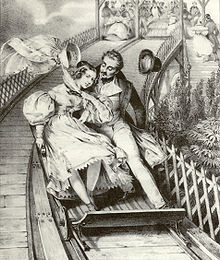Tivoli (Vienna)
Tivoli was a famous entertainment establishment in the former Vienna suburb of Obermeidling . It was located between today's streets of Hohenbergstrasse , Tivoligasse and Grünbergstrasse, now in the 12th district of Meidling .
history
Based on the model of slides invented in Russia and built in several major European cities, the Berlin entrepreneurs Friedrich Emil Gericke and Ernst Wagner also opened such a facility in Vienna. The name Tivoli was chosen because of the beautiful view that one had from the slide of the Wiental and the city of Vienna behind it, after Tivoli, east of Rome, famous for its gardens .
In 1829 the entrepreneurs bought a plot of land on the Grüner Berg in Meidling. At that time it was a posh villa town with a spa ( Theresienbad ) near the imperial Schönbrunn Palace . In a short time they built a luxurious entertainment establishment for the upper classes, in which they could eat and dance. It consisted of several buildings with a platform in front from which one could enjoy the aforementioned beautiful view of Vienna. In the garden below was the slide with four side-by-side tracks and about 15 two-seater wagons with which one drove the undulating route.
The restaurant was opened in 1830, accompanied by numerous advertising measures and advertisements in newspapers. Additional attractions such as lantern festivals or fireworks also provided variety for the guests. Of decisive importance for the success of the facility was the permanent engagement of the orchestra of Johann Strauss Vater , which repeatedly performed new compositions of waltzes and other dances in a pavilion in the garden.
The opening on September 5th took place in the presence of the imperial couple, on the second opening day, September 9th, 2000 guests from the high nobility were invited. Large celebrations were held again and again, such as B. 1831 with fireworks by Johann Georg Stuwer under the title Mädchen aus der Feenwelt or in 1832 a Chinese lantern festival with Strauss waltzes. In 1834 the last cockfights on Viennese soil took place at Tivoli .
Ferdinand Raimund created a Tivoli song in his play Die gefesselte Phantasie in 1830 , which was very popular with the audience. Compositions by Johann Strauss Vater for Tivoli were the Tivoli-Rutsch-Walzer , op. 39 (1830), Tivoli-Freudenfest-Tänze , op. 45 (1831), Vive la Danse! , op.47 (1831), A bouquet of bouquet - from clay flowers (1832), Zampa -Walzer , op.57 (1832), The joy of my goal , op.63 (1833), First Walzer-Guirlande , op.67 (1834) and Heimath-Klänge , op.84 (1836).
From 1834 on, the establishment could no longer be run profitably due to the high operating costs. New owners, such as Johann Junge (1836) or Karl Demuth (1837), tried in vain to change something by adding new attractions and extending the slide. It was only Franz Lechner who managed to save Tivoli in 1844, where he successfully established a dairy and snack bar under the name of Little Tivoli, and the slide was dismantled. A plan to parcel out the site and build a residential area there failed.
Lechner mainly engaged the young Johann Strauss son at the beginning of his career as a composer and conductor. The Patrioten-Marsch , op. 8 (1845) and the Walzer Berglieder , op. 18 (1845) and Die Zillerthaler , op. 30 (1846) were premiered in Tivoli by Johann Strauss Sohn .
In 1873 Johann Wallner became the owner. During his time, the Tivoli was again visited by prominent personalities, such as the artists Gustav Klimt and Egon Schiele at the turn of the century . Wallner built a large wooden pavilion above the dairy, which was painted with pictures by the painter Anton Hlavaček . A bust of Hlavaček by Fritz Hänlein was placed here in 1925. In the first half of the 20th century, near Tivoli, was the so-called “Meidlinger Prater ” with swings and ring games.
During the Second World War, the Tivoli was closed and then fell into disrepair, so that operations were ceased in 1967. It was devastated by arson in 1980 and demolished in 1991. Today, the Am Tivoli residential complex , the Tivolibrücke and the Tivoligasse are still reminiscent of the former entertainment venue.
literature
- Günther Berger: The Tivoli in Meidling , 1989
- Felix Czeike: Historical Lexicon Vienna Vol. 5 . Kremayr & Scheriau, Vienna 1997
- Hans W. Bousska: Take me out, out to Tivoli for the bouquet. Johann Strauss (father) and the Tivoli in Meidling . Sheets of the Meidlinger District Museum issue 48/1999
Coordinates: 48 ° 10 ′ 40 ″ N , 16 ° 19 ′ 0 ″ E

